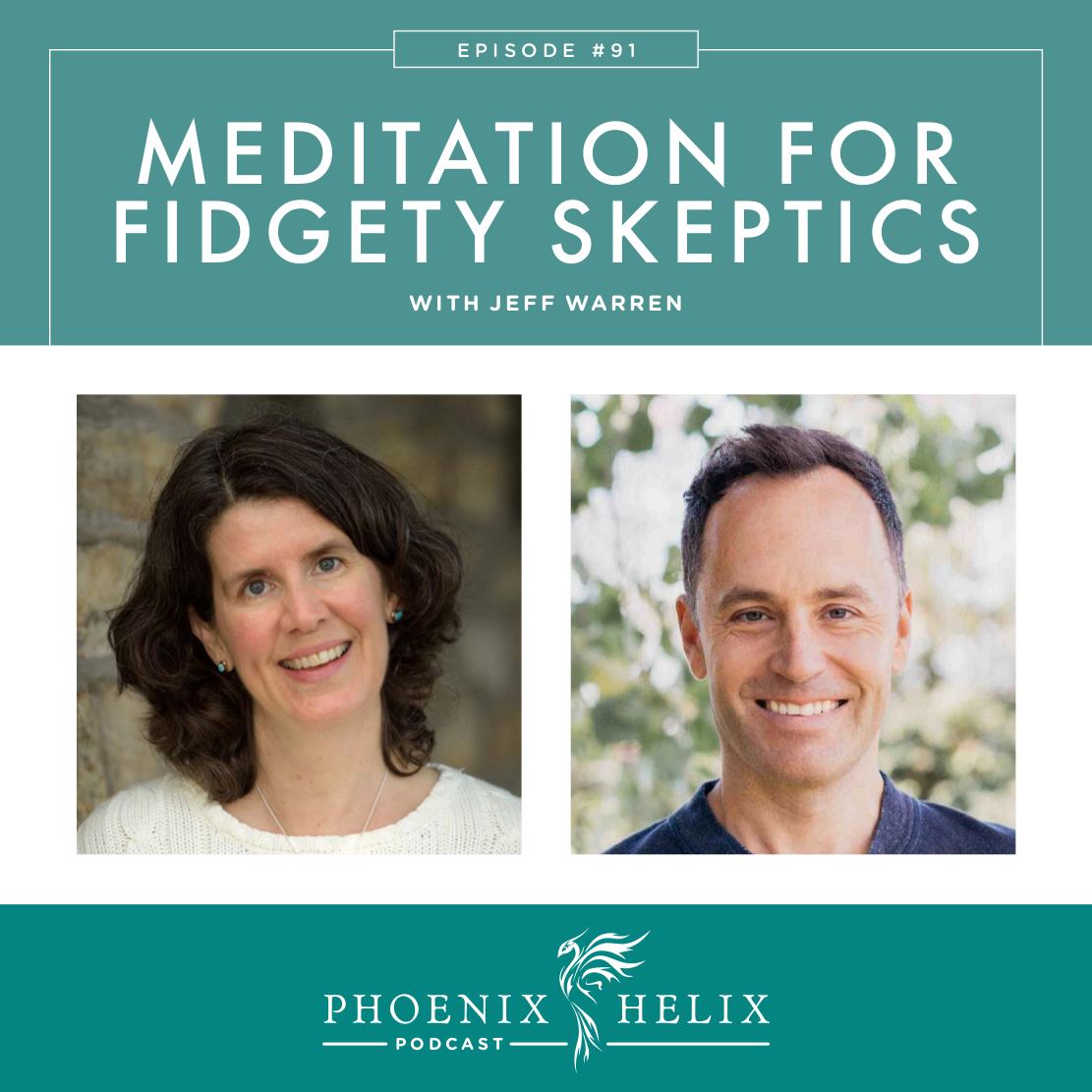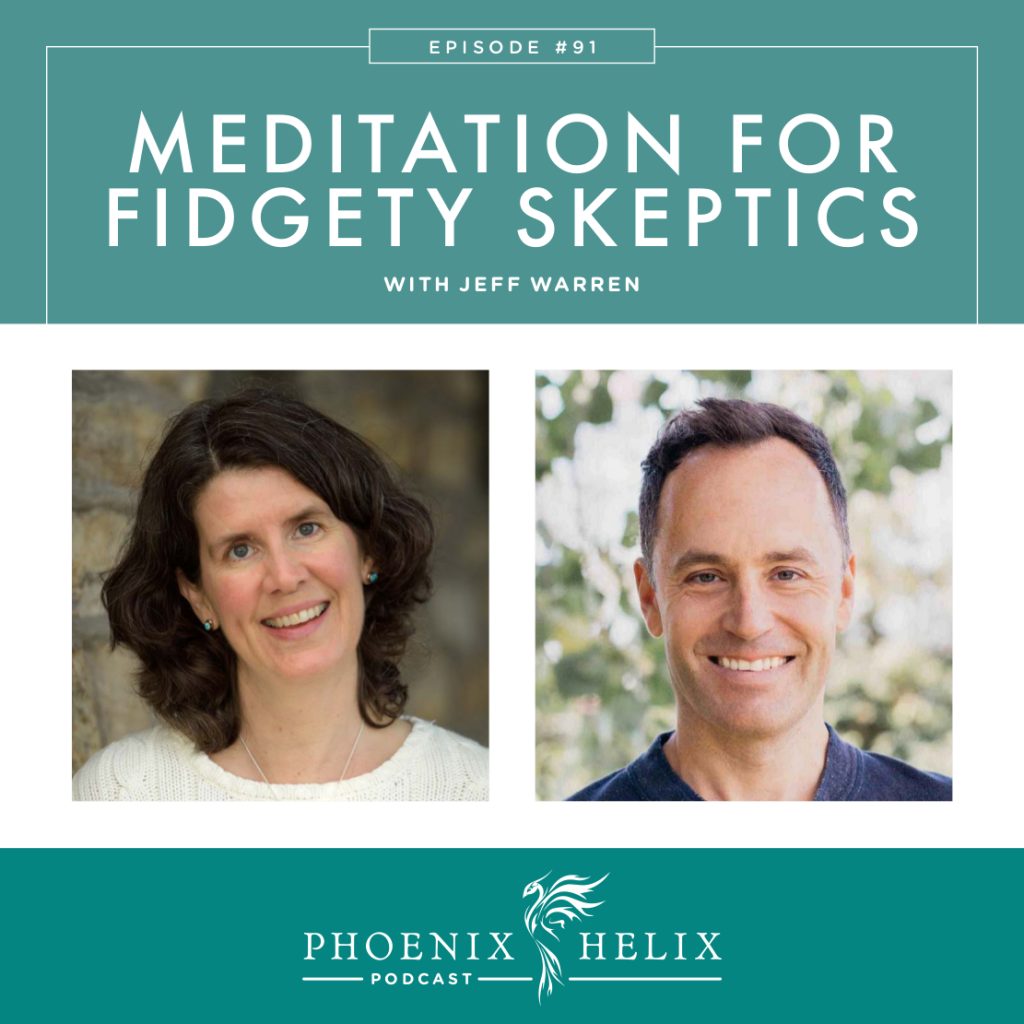If You Think You Can’t Meditate, this Podcast Is for You!
Do you picture meditators sitting quietly and peacefully with completely empty minds, people genetically wired totally differently from you? Let me tell you a secret: those people don’t exist. Even the Dalai Lama has thoughts while he meditates. The mind is designed to think, so meditating isn’t about stopping thoughts; it’s learning how to notice and detach from them. And while some people might find sitting still easier than others, there are actually many ways to meditate, including moving meditations or simply learning how to be mindful in daily life. My guest is Jeff Warren, who co-wrote the book Meditation for Fidgety Skeptics. Jeff is a world-renowned meditation teacher who is known as the “Macgyver of Meditation”. He excels at “fixing” people’s meditation problems – finding inventive ways to help us overcome our obstacles to developing a personal practice. In this episode, we talk specifically about common meditation obstacles for people with autoimmune disease.
Listen to the Show
- Subscribe to my podcast through your favorite podcast app: iTunes, Stitcher, Google, TuneIn, Spotify, Amazon, etc.
- You can also listen to the episode right here through the player below, and if you subscribe to my newsletter you’ll get notified of future episodes.
Podcast: Play in new window | Download
Show Notes
- Intro (0:00)
- Eileen’s Updates (1:37)
- My podcast just passed an important milestone: 1 Million Downloads! Big thanks to all of you for listening!
- Welcoming a New Podcast Sponsor: Shop AIP (2:52)
- An online store, where everything sold is compliant with the elimination-phase of the Paleo Autoimmune Protocol.
- They sell a wide variety of products, including protein bars, AIP-friendly spice blends, cooking and baking ingredients, snacks, non-toxic skincare, and more. They also have themed bundles to make shopping even easier.
- Place your order here, and use the code PHOENIX for 10% off your first order.
- Meet Jeff (4:20)
- Jeff Warren is a world-renowned meditation teacher and founder of the Consciousness Explorers Club in Toronto. He’s co-author of the book Meditation for Fidgety Skeptics, and his first book was called Head Trip. It was research for his first book that led him to meditation. He attended his first retreat in 2004 and has been practicing ever since.
- He personally found meditation challenging, but he also experienced some immediate benefits. He was able to see how his mind could generate problems. Meditation also helped him feel more “settled” – Jeff has clinical Attention Deficit Disorder, so this was a great benefit. Then over years of practice, learning how to sit with the ups and downs of meditation helped him develop greater equanimity during the ups and downs of life.
- Meditation Benefits – Why Do It? (10:49)
- Equanimity – the ability to withstand the ups and downs of life with more peace, clarity, and compassion. Jeff calls this the opposite of inflammation.
- Improved focus and attention.
- Reduced stress reactivity.
- Loving-Kindness Meditation increases compassion and interpersonal interactions.
- Some studies specific to autoimmune disease and chronic illness:
- Multiple sclerosis – reduced depression, anxiety and fatigue.
- Rheumatoid arthritis – didn’t affect disease activity, but did significantly reduce the psychological distress which often comes with the disease.
- Inflammatory Bowel Disease – reduced pain, anxiety and even altered gene expression.
- Fibromyalgia – reduced pain, anxiety and depression, and those improvements remained 3 years later.
- Types of Meditation – There is No One Right Way (22:07)
- When we think of meditation, we often picture someone sitting still, eyes closed, focused on the breath. That is one type of meditation, but it’s not the only type.
- For people who have difficulty sitting still, moving meditations or mindfulness practice in daily life might be a better choice.
- Some people find it stressful to focus on the breath, especially if they have a history of asthma. You can focus on anything – it doesn’t have to be the breath. Some alternatives include mantras, music, sounds, gratitudes, a visualization, or different sensations in the body.
- The type of meditation doesn’t matter. What matters are the qualities of attention you bring to it:
- Concentration – learning to notice when your mind wanders and bringing your attention back to the meditation.
- Clarity – developing the skill of really noticing the present moment and being able to separate thoughts from experience.
- Equanimity – being open to the present moment and all that it entails, without resistance.
- Friendliness – being gentle and caring toward ourselves as we develop our meditation practice (as opposed to judgmental).
- Note: these are qualities that develop with practice; they aren’t innate, and perfection isn’t the goal. It’s called a meditation “practice” for a reason.
- Meditation Resources:
- Free Guided Meditations by Jeff Warren including one on Finding the Right Practice for You.
- Guided Meditation by Eileen Laird designed specifically for people with autoimmune disease.
- Article: Meditation – It’s Easier Than You Think.
- Book: Meditation for Fidgety Skeptics.
- App: 10% Happier.
- Have You Failed If You Can’t Quiet Your Mind? (29:14)
- No! The mind is designed to think. The brain excretes thoughts like the digestive system excretes enzymes. It’s completely natural and sometimes really beneficial. Thoughts lead to inventions, creativity, problem solving, etc. Thinking becomes a problem when it’s chronic, fixated, amplifies the stress response, and we can’t disengage from it. Meditation isn’t the practice of eliminating thought. It’s the practice of becoming consciously aware of our thoughts and learning to detach from them. Meditation is simply noticing when your mind wanders, letting those thoughts go, and returning your focus to the meditation. Each time you do that, you’re strengthening your meditation muscle. When you catch yourself thinking during meditation, that’s actually success, not failure.
- Helpful tool: Mental Noting.
- Tips for Beginners (34:37)
- Make it simple & start with a short goal: a 10 minute daily practice.
- Have the mindset that this isn’t a big deal; you’re just exploring and experimenting. No pressure.
- When you choose something to focus on, see what feels appealing. Is it your breath? Is it the warmth of your hands? Is it the air on your skin? Is it a sound?
- Do your best to focus on that for 10 minutes. When your mind wanders, notice that, let it go, and return to your point of focus.
- Be gentle with yourself in this practice. There is a learning curve, and it’s not about being perfect.
- Do this for 1-2 weeks and see if you notice a difference in your life. It’s not what happens during meditation that matters; it’s the benefits you feel in your life.
- Once 10 minutes feels comfortable, try increasing to 15-20 minutes daily. Whatever works for you.
- Thank You to our Podcast Sponsor – Paleo on the Go (37:29)
- A frozen meal delivery service, they have a large menu of items for the paleo autoimmune protocol (AIP).
- Use the code PHOENIX for 10% off your first order.
- Life’s Too Busy. I Don’t Have Time to Meditate (38:43)
- Mindful Moments: You can turn almost any moment in your life into a meditation. For example, say you’re waiting in line for the ATM. Just close your eyes and focus on the feeling in your hands or the sounds around you. That can be a meditative moment. Resource: 40 Ways to Bring Mindfulness to Your Days.
- Schedule Spaces: Find the spaces within your daily schedule where you can add a little meditation time more easily. When you first wake up in the morning, take a few minutes to meditate before doing anything else. If you commute with public transit, your commute can be meditative time. If you drive to work, meditate for 5 minutes in the parking lot before going inside.
- Meditation Corner: This is optional, but if you have a place in your home that your can set up as your meditation corner, you’ll start to associate positive feelings with this space and want to spend more time there. This is especially true if you make it comfortable and decorate it in a way that makes you feel more peaceful.
- The Shift: While meditation feels like work in the beginning, over time it can become something you truly enjoy. At first, it can be a struggle to fit it into our lives. Over time, we start to see ways to make our lives more meditative.
- Resource: Podcast Ep. 121: Time Management with Laura Vanderkam.
- Meditation Through Pain (44:00)
- Suffering = Pain x Resistance. The goal of meditation is to remove the resistance – the bracing against the pain which can amplify it, and the inflammatory thoughts and emotions that often spiral when we’re hurting.
- Strategy 1: Distraction – focusing your attention somewhere else besides the pain. When we’re in pain, it can become our whole world. This technique widens our perspective, and the pain often becomes less overwhelming.
- Strategy 2: Lean into it – objectively tune into the pain and separate the pain from your response to it. Sometimes this helps dissipate the pain. Other times it makes it easier to bear. It’s also possible the pain may spike; go back to strategy 1 if that happens.
- Body Scan Meditation – this is a way to move back and forth between strategies 1 and 2.
- RAIN: Recognize, Allow, Investigate, Non-Identification. This is a very helpful technique when working with difficult feelings (physical or psychological).
- Resources:
- Podcast Ep. 152: Mind-Body Techniques for Pain with Vidyamala Burch.
- Break Through Pain by Shinzen Young.
- Working with Difficult Emotions (53:15)
- Meditation often brings unconscious thoughts and emotions into consciousness.
- The same techniques shared earlier regarding physical pain can also help with emotional pain.
- However, for deep anxiety and depression, outside assistance might be needed, especially for people who have experienced a lot of trauma. Meditation can be a complementary technique to psychotherapy, rather than the sole technique to work with these emotions. In fact, some therapists have training in both meditation and trauma techniques.
- Guided Meditation by Jeff (1:01:36)
- During the podcast, Jeff led a guided meditation for beginners.
- He also has many other guided meditations on his website.
- Outro (1:09:29)
- You can keep up with Jeff’s work through his website. His books are Meditation for Fidgety Skeptics and Head Trip. And he is a founder of the Toronto-based Consciousness Explorers Club.
- Eileen (your podcast host) is the author of multiple books, written to help people thrive with autoimmune disease. Learn more on the Books Page.
- If you like this podcast, follow or subscribe through your favorite podcast app. You can also subscribe to Eileen’s biweekly newsletter.
- Check out the entire archive of podcast episodes.
You May Also Be Interested In
Spreading the Word
If you like the podcast, please leave a positive review in iTunes. It would mean the world to me, and also helps others find the podcast. Here are some quick instructions using your iPhone:
- If you are already subscribed to my podcast: (1) Click the purple podcast icon. (2) At the bottom of the screen, click Library. (3) At the top of the screen, click Shows. (4) Click the Phoenix Helix podcast image. (5) Scroll down the page, and you’ll see Ratings and Reviews. Scroll down a little bit more and click on Write a Review. This will bring up the review screen. Tap 5 stars (if you love the podcast), and then click in the title box, and it will bring up the keyboard. Enter a title and short review. (6) Click Send in the upper right corner. (7) Thank you! Positive reviews give the podcast a higher search ranking in iTunes, helping people find it and letting them know it’s a quality podcast and worth their time to listen.
- If you haven’t subscribed to my podcast: (1) Click the purple podcast icon. (2) In the lower right corner, click the magnifying class. (3) Type Phoenix Helix in the search box. (4) Click the podcast cover in the Show list. (5) If you’d like to subscribe, click the + sign at the top of the screen. (6) To write a review, scroll down the page, and you’ll see Ratings and Reviews. Scroll down a little bit more and click on Write a Review. This will bring up the review screen. Tap 5 stars (if you love the podcast), and then click in the title box, and it will bring up the keyboard. Enter a title and short review. (7) Click Send in the upper right corner. (8) Thank you! Positive reviews give the podcast a higher search ranking in iTunes, helping people find it and letting them know it’s a quality podcast and worth their time to listen.









